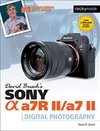
David Busch’s Sony Alpha a7R II/a7 II Guide to Digital Photography

(I recommend the same Panasonic eneloop batteries that power my flash units)
David D. Busch • David Busch’s Sony Alpha a7R II/a7 II Guide to Digital Photography
won’t be recommending specific tripods, because they are one component that it’s foolish to skimp on. Photo guru Thom Hogan explains why eloquently in a classic 2003 blog posting you can find here: http://www.bythom.com/support.htm. Suffice it to say that I personally never rely on a cheap tripod; even my ultra-compact Gitzo Traveler (which is
... See moreDavid D. Busch • David Busch’s Sony Alpha a7R II/a7 II Guide to Digital Photography
Head-and-shoulders portraits of humans tend to be more flattering when a focal length of 50mm to 85mm is used with a full-frame camera. Longer focal lengths compress the distance between features like the nose and ears, making the face look wider and flat. (Conversely, a wide-angle lens will make the nose look huge and ears tiny if you move close
... See moreDavid D. Busch • David Busch’s Sony Alpha a7R II/a7 II Guide to Digital Photography
if you use the widest setting of such a zoom, and point it at a part of a scene that’s at the proper 90-degree angle from the sun, the areas of the scene that are at the edges of the frame will be oriented at much wider angles from the sun. Only the center of the image area will be at exactly 90 degrees. When the filter is used to darken a blue
... See moreDavid D. Busch • David Busch’s Sony Alpha a7R II/a7 II Guide to Digital Photography
I get some use out of a set of Fotodiox anodized aluminum 49-52mm, 52-55mm, 55-58mm, 58-62mm, 62-67mm, 67-72mm, and 72-77mm step-up rings, which can be used in combination for multiple “steps.” I also have the Fotodiox 77-72mm, 72-67mm, 67-62mm, 62-58mm, 58-55mm, 55-52mm, and 52-49mm step-down rings. These come in handy when I want to fit a
... See moreDavid D. Busch • David Busch’s Sony Alpha a7R II/a7 II Guide to Digital Photography
reduce the traveling size of my filter kit by threading all my 72mm filters together into a stack. Then a threaded “stack cap” set with a male threaded screw in 72mm front cap and female threaded 72mm rear cap allows carrying. If I’m traveling with just my “trinity,” I screw the 67-72mm step up ring into the back of the stack and use a 67mm rear
... See moreDavid D. Busch • David Busch’s Sony Alpha a7R II/a7 II Guide to Digital Photography
Some Sony lenses, like the superb FE 50mm f/1.8 Zeiss, take 49mm filters, quite a few Sony or Minolta lenses use 55mm filters, while the f/4 maximum apertures of the Sony “trinity” discussed in Chapter 12 require 67mm filters (for the 24-70mm f/4 Zeiss) or 72mm filters (for the 70-200mm f/4 and 16-35mm f/4 optics). If you choose to use a
... See moreDavid D. Busch • David Busch’s Sony Alpha a7R II/a7 II Guide to Digital Photography
But your polarizer, infrared, and neutral-density filters can all be shared among your lenses through the use of inexpensive step-up and step-down rings. The former allow using larger filters on lenses that have smaller diameter filter threads
David D. Busch • David Busch’s Sony Alpha a7R II/a7 II Guide to Digital Photography
However, for occasional use, I find that third-party black-anodized aluminum platforms (for $50 or less) and camera plates ($15 to $30) do a great job. One platform that may work for you is the Neewer Professional Smooth Round Quick Release Clamp, which I found on Amazon for about $17.